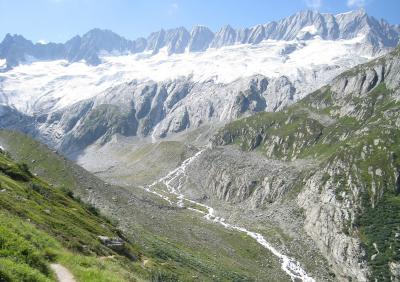Soil organic matter makes up the bulk of terrestrially bound carbon in our biosphere. Those compounds play an important role, not only for soil fertility and agricultural yields but also for controlling the concentration of carbon dioxide in the atmosphere.
Climatic change can therefore be slowed down or accelerated according to our management of soil resources. A new study sheds some light on the process.
The remains of dead bacteria have far greater meaning for soils than previously assumed, around 40 percent of microbial biomass is converted to organic soil components, say researchers in a new paper.
It has been assumed that the organic components of the soil were comprised mostly of decomposed plant material which is directly converted to humic substances. In a laboratory experiment and in field testing, researchers have clarified things. Evidently the easily biologically degradable plant material is initially converted to microbial biomass which then provides the source material to soil organic matter.

Electron micrograph shows bacteria (Hyphomicrobium sp.; Yellow) growing up partly on solid surfaces, floors and sediment grains. During growth whatsoever cells die and deformed or fragmenting cell envelopes remain. Small-scale fragments of these shells (red) then set the microparticulate matrix in soils and sediments. Photo: Burkhard Schmidt-Brücken, Institute of Material Science/Dresden University of TechnologyColored by: Christian Schurig, Helmholtz Centre for Environmental Research
In a laboratory incubation experiment, the researchers initially labeled model bacteria with the stable isotope 13C and introduced the bacteria to soil deriving from the long-term cultivation experiment "Ewiger Roggenbau" in Halle/Saale.
Following the incubation time of 224 days the fate of the carbon of bacterial origin was determined.
"As a result we found fragments of bacterial cell walls in sizes of up to 500 x 500 nanometres throughout our soil samples. Such fragments have also been observed in other studies, but have never been identified or quantified", sayss Professor Matthias Kästner of the Helmholtz Centre for Environmental Research (UFZ).
The accumulation of the bacterial cell wall fragments appears to be supported by peptides and proteins from the liquid interior of the cells, which remain to a greater extent in the soil than other cell components. These materials enable the formation of a film of organic molecules on the mineral components of the soil, on which the carbon from the dead bacteria is accumulated and stabilized.
When the fragments of the bacterial cell walls dry out, they may lose their rubber-like properties and can harden like glass. If the soil subsequently becomes moist again, however, under certain circumstances they cannot be re-wetted – an important prerequisite for their degradation by other bacteria. This would provide the simplest explanation for the stabilisation of theoretically easily degradable carbon compounds in soil.
"This new approach explains many properties of organic soil components which were previously viewed as contradictory", says Kästner. In the late 1990s, Kästner and his team arrived at this idea on the basis of earlier investigations on the degradation of environmental contaminants like anthracene in polluted soils of former gas work sites. In these investigations, isotopic analyses revealed bound carbon residues which have been of bacterial origin.
Following the laboratory experiment, their hypothesis was tested in field research. In summer of 2009 the researchers took soil samples in the forefield of the Damma Glacier in the Swiss Canton Uri. In the course of the last 150 years glacier has retreated by around one kilometer. In its place granite rock remained behind, which was gradually recolonized by living organisms accompanied by soil development. Following the formation of new soil the first plants, such as mosses and grasses, were followed by bushes and, later, also by trees.
In the meantime, the Damma Glacier, on which a broad range of studies is being conducted, has therefore become an important outdoor laboratory not only for climate researchers, but for ecologists as well.

In the last 150 years, Damma Glacier has retreated by around one kilometer, exposing granite rock which was gradually re-colonized by living organisms accompanied by soil development. Following the formation of new soil, mosses and grasses were followed by bushes and then by trees. Photo: Christian Schurig, Helmholtz Centre for Environmental Research
The soil investigated with the samples was between 0 and 120 years old and thus allowed insight into early processes of soil development. Scanning electron microscopic investigations which followed at the Max Planck Institute for Developmental Biology in Tübingen also indicated that the covering of the soil mineral particles by a film comprised of bacterial cell wall residues had increased with the soil age.
The results of the outdoor investigations therefore confirmed the hypothesis and the laboratory results. This new knowledge was ultimately made possible by recent advances in scanning electron microscopy, which in the meantime enable the identification and evaluation of the soil nano-components.
The predominant share of the plant debris in fertile soil is thus rapidly processed by micro-organisms, e.g. bacteria, leading to more bacteria and, in turn, also to more cell fragments. This then results in more organic material in the soil.
"Even though the greatest part of the organic carbon in the eco-systems is definitively produced primarily by plants, we were able to show that a large part of the organic material is actually comprised of residues of bacteria and fungi. This underscores the importance of bacteria as organisms in all types of soil," summarizes Kästner.
Furthermore, they are important for the global climate: The degradation of these organic material results, in mineralization products and the greenhouse gas carbon dioxide (CO2). According to estimates from Great Britain the amount of CO2 escaping annually to the atmosphere due to the degradation of organic material in the soils of England and Wales is in the order of magnitude by which greenhouse gas emissions are annually reduced there. This means that no rigorous progress in climate protection may be accomplished without first protecting the soil.
Published in Biogeochemistry




Comments